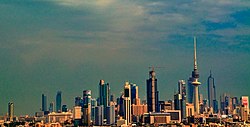Kuwait city
|
Kuwait مدينة الكويت Madinat Al-Kuwayt |
|
|---|---|

The Skyline of Kuwait City
|
|
| Nickname(s): مدينة الكويت [Ad-Dirah] | |
| Location of Kuwait in Kuwait | |
| Coordinates: 29°22′11″N 47°58′42″E / 29.36972°N 47.97833°ECoordinates: 29°22′11″N 47°58′42″E / 29.36972°N 47.97833°E | |
| Country | Kuwait |
| Governorate | Al Asimah |
| Area | |
| • Metro | 200 km2 (80 sq mi) |
| Population | |
| • Urban | 2.4 million |
| Time zone | AST (UTC+3) |
Kuwait City (Arabic: مدينة الكويت) is the capital and largest city of Kuwait. Kuwait City is the political, cultural and economic center of Kuwait. Kuwait City is considered a global city. Kuwait City's trade and transportation needs are served by Kuwait International Airport, Mina Al-Shuwaik (Shuwaik Port) and Mina Al Ahmadi (Ahmadi Port).
In 1613, the town of Kuwait was founded in modern-day Kuwait City. In 1716, the Bani Utubs settled in Kuwait. At the time of the arrival of the Utubs, Kuwait was inhabited by a few fishermen and primarily functioned as a fishing village. In the eighteenth century, Kuwait prospered and rapidly became the principal commercial center for the transit of goods between India, Muscat, Baghdad and Arabia. By the mid 1700s, Kuwait had already established itself as the major trading route from the Persian Gulf to Aleppo.
During the Persian siege of Basra in 1775–1779, Iraqi merchants took refuge in Kuwait and were partly instrumental in the expansion of Kuwait's boat-building and trading activities. As a result, Kuwait's maritime commerce boomed. Between the years 1775 and 1779, the Indian trade routes with Baghdad, Aleppo, Smyrna and Constantinople were diverted to Kuwait. The East India Company was diverted to Kuwait in 1792. The East India Company secured the sea routes between Kuwait, India and the east coasts of Africa. After the Persians withdrew from Basra in 1779, Kuwait continued to attract trade away from Basra.
Kuwait was the center of boat building in the Persian Gulf region. During the late eighteenth and nineteenth centuries, ship vessels made in Kuwait carried the bulk of trade between the ports of India, East Africa and the Red Sea. Kuwaiti ship vessels were renowned throughout the Indian Ocean. Regional geopolitical turbulence helped foster economic prosperity in Kuwait in the second half of the 18th century. Kuwait became prosperous due to Basra's instability in the late 18th century. In the late 18th century, Kuwait partly functioned as a haven for Basra's merchants fleeing Ottoman government persecution. According to Palgrave, Kuwaitis developed a reputation as the best sailors in the Persian Gulf.
...
Wikipedia

